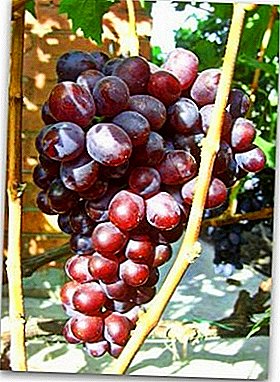 One of the reasons why chickens are kept in the yard is, of course, getting homemade eggs. In order for the hens to not sleep anywhere, but to do it in one specific place, you need to make such a place attractive for them - namely, comfortable, convenient, thought out to the smallest detail. Let's talk about how to make roosts for laying hens.
One of the reasons why chickens are kept in the yard is, of course, getting homemade eggs. In order for the hens to not sleep anywhere, but to do it in one specific place, you need to make such a place attractive for them - namely, comfortable, convenient, thought out to the smallest detail. Let's talk about how to make roosts for laying hens.
Did you know? In good housing and favorable conditions, chickens produce more eggs.
Rooster requirements for chickens
When equipping a perch, it is necessary to take into account the physiological characteristics of birds. In addition, its size and location of the rails will depend on the breed of chickens, their number, the size of the chicken coop and your abilities.
First, you need to understand that the roost is reiki, sticks, poles, crossbars, fixed in the poultry house on both sides, intended for rest and sleep of domestic birds. Therefore, the roost should be placed in a dark and warm place, away from drafts.
Consider how sleep chickens. They carry a state of sleep in a sitting position. In doing so, they bend the knee joint. The tendons that go to the paws stretch, and the muscles contract - as a result, the birds squeeze their fingers. Therefore, being on the pole, the chicken clasps it with his fingers and drives the claws into the wooden surface. It is in this position that she sleeps, and at the same time she feels comfortable and calm.  Taking into account the peculiarities of the birds' stay during the rest, it can be concluded that the perches made in the form of shelves will be inconvenient for the chickens and contradict their physiology.
Taking into account the peculiarities of the birds' stay during the rest, it can be concluded that the perches made in the form of shelves will be inconvenient for the chickens and contradict their physiology.
The main requirement for the manufacture of "bed" is the height of the perch for chickens from the floor. When calculating it, you need to focus on the size of your chickens. If they are small, the poles can be placed at a distance of 60-80 cm from the floor. Also 80 cm should raise the crossbar for heavy layers.
Too low to attach them is not worth it, because the birds need to move - to land on the roost they will need to jump and take off. This will be a kind of charging for them. However, climbing a pole for chickens should not be particularly difficult. Therefore, the location of the perch above 1 meter from the floor is not recommended.
Did you know? Mounts for crossbars can be made at different levels to change depending on the new livestock or after the chickens or young chickens grow up and they need to roost higher.Other requirements for the roost for chickens, in particular, for such dimensions as width and length, are not made - they will depend on the size of the house and the number of birds. The length of the poles must be the same with the width of the chicken coop. Their side parts need to be rounded so that the birds can comfortably hold onto them. The width of the bar should be comfortable for his grasping - about half of the open paw of a chicken.
The length should be calculated from the number of birds, so that they can sit comfortably, without constraining each other. One layer takes an average of 20-30 cm. The distance between the beams is recommended from 30 to 60 cm.  You can use the already developed recommendations about the roosts for different types of chickens and their optimal sizes. So, for chickens, the best perch will be 90 cm high, the size of the bar is 4 x 6, the distance between the poles is 25-30 cm. The length of the perch is calculated at the rate of 17-18 cm per bird. Thus, if you have 10 laying hens, the length of the bar will be: 18 x 10 = 180 cm plus 30 cm of space from each wall. As a result, we get a pole length of 2 m 40 cm.
You can use the already developed recommendations about the roosts for different types of chickens and their optimal sizes. So, for chickens, the best perch will be 90 cm high, the size of the bar is 4 x 6, the distance between the poles is 25-30 cm. The length of the perch is calculated at the rate of 17-18 cm per bird. Thus, if you have 10 laying hens, the length of the bar will be: 18 x 10 = 180 cm plus 30 cm of space from each wall. As a result, we get a pole length of 2 m 40 cm.
For chicken meat and egg breeds, the height of the perch should be made at a distance of 60 cm from the floor. The size of the bar should be 5 x 7, the intervals between the poles - 30-35 cm. The length of 20-25 cm per bird.
Important! It is best to roost the hens with a slight inclination of 10 degrees so that the eggs can slide into the pan without damage.When equipping a roost it is also necessary to take into account such details as the convenience of cleaning the hen house, the convenience of collecting eggs. It is important to provide the optimal distance of the poles from the wall so that the tails of the birds are located there comfortably. In addition, when calculating the length of the poles, it is necessary to attach importance to the fact that in winter the birds sit tightly together so that it is warmer. In the summer, on the contrary, they try to stay away from their neighbors.
Types of chickens perches: advantages and disadvantages of each
Perches can be equipped in several ways. We suggest you to get acquainted with four types of perches. Assessing the pros and cons of each of them, you can choose the one that is right for you and your birds.
Perches at different levels
This method of roosting in the hen house is the simplest and most common. Its principle is that perches are placed along one wall or another in a corner one above the other.  The advantages of such a perch are its ease of manufacture, compactness, convenience for layers. The disadvantages include the fact that when the birds are placed one above the other, the upper ones will soil their lower droppings. This is, firstly, not hygienic. Secondly, for this reason, conflicts can occur in birds - each bird will tend to take a place closer to the top.
The advantages of such a perch are its ease of manufacture, compactness, convenience for layers. The disadvantages include the fact that when the birds are placed one above the other, the upper ones will soil their lower droppings. This is, firstly, not hygienic. Secondly, for this reason, conflicts can occur in birds - each bird will tend to take a place closer to the top.
The crossbar on the perimeter of the coop
The crossbar located around the perimeter of the house at the same or different levels (less). This roost is also easy to make and convenient for birds. They will have more choice where to spend hours of sleep, which means that hassles about this can be avoided. Plus: none of them will smear their hen house neighbors with their excrement. This roost does not require much space. 
Table with poles
A table with poles is a portable structure. To make a similar perch for laying hens with your own hands, you will need drawings, a little more time and effort than other types of “sleeping places”. Its main advantage is hygiene: it is easy to clean and disinfect. You can also move to any place. 
Box with poles
The box with perches is a variation of the previous species of perch. It is suitable for placing a small number of birds. 
Instructions for making a perch for laying hens with your own hands
To make any of the types of perches is quite simple. With the necessary materials and tools it can make almost everyone.
Necessary tools and materials
In order to independently make a roost, you will need the following tools:
- plane;
- hammer;
- screwdriver;
- sandpaper;
- nails or screws;
- screws.
How to make a roost with your own hands
Standard nest is done as follows. The bar used as a pole should be treated with a plane and sanded to a smooth surface so that birds do not injure their paws. From the recommendations on how to make roost in the hen house correctly, you have already learned that the number of poles and their length must be calculated using parameters such as age, weight and number of birds.
Then the support bars are installed at a height of 90 cm. The length on the sides is 60 cm. In advance, you can cut out the grooves into which the poles will be inserted. Also, the crossbar, you can just nail down.
Each pole is nailed to a support at a distance of 30 cm from the wall. The gaps between two poles must also be 30 cm. 
Important! When equipping the “bed” for chickens, one should not neglect the recommendations for the location of the perch - it should be located far from the entrance, in a warm corner, preferably not far from the window.After all the poles are nailed, it is necessary to equip the tray for bird droppings. To do this, you need to measure 40 cm from the floor, nail the bars on the sides, attach the boards to which the pallet is placed. The pallet itself can be both wooden and plastic, metal, plywood. To remove the excrement was easier, you can pour sand or sawdust on its bottom. At the very end, it is necessary to equip the ladder, so that the inhabitants of the upper poles will find it easier to climb.
 It is better if in such a perch poles are removable and you will provide attachments at different heights. So their location can be adjusted over time.
It is better if in such a perch poles are removable and you will provide attachments at different heights. So their location can be adjusted over time.You also need to talk about how to make a portable roost in the hen house. You will need:
- boards 15 cm high, 2 cm thick - 4 pieces;
- plywood - 1 piece;
- grid.
 There is another version of the perch. In it, for example, you can convert an old table. If this did not happen, you will have to make it yourself.
There is another version of the perch. In it, for example, you can convert an old table. If this did not happen, you will have to make it yourself.On the table top nailed strips with grooves under the poles. Poles are inserted into them. Separately mastered pallet, which stretches the grid.
How to accustom chickens to roost
Often, the owners of chickens are faced with the fact that the birds are resting and rushing in places where they want, and simply ignore the roost. This is especially true of young individuals that behave like this because of ignorance. If you are sure that your perch is fulfilled according to all the rules and the birds do not experience any discomfort on it, then you can try to teach them to sleep on poles.
However, the process of schooling will be exhausting, since chickens have to sit on the crossbar with their own hands every evening for a week or even longer. This should make them a habit, and after some time they will independently jump on the roost.
Did you know? To train the hens to rush to certain places, nests, they need to lay one egg at a time, then the chickens will follow the example and will also report their eggs next to each other. Gradually this will become their habit.We considered only a few options for how to make a roost. In fact, a large number of them. You can use a variety of materials at hand that will greatly simplify and cheapen the process of manufacturing a "berth" for birds. However, the criterion, which must always come first, is comfort and convenience for chickens. The only way to achieve their well-being and excellent egg production.












